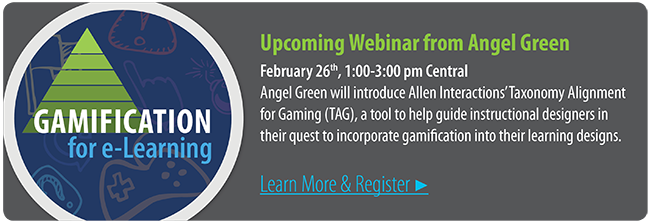Blog
Gamify Your e-Learning Solutions: A Trend 20 Years in the Making
By Ethan Edwards, chief instructional strategist | @ethanaedwards and Angel Green, senior instructional strategist | @LearnerAdvocate Due to the ...


Confusion, Trends & Possibilities with Gamification for e-Learning
By Angel Green | February 24, 2014 | Custom Learning | 0 Comments

By Ethan Edwards, chief instructional strategist | @ethanaedwards and Angel Green, senior instructional strategist | @LearnerAdvocate
Due to the interest in, and response to, several of our blog posts, white papers, and webinars on gamification, Ethan Edwards and I provide answers and insight around some of the pressing topics related to incorporating gaming into your learning programs.Let’s set a common lexicon so that we can move beyond terms and into the heart of the topic. There seems to be some confusion about the differences between the terms of gamification and a learning game. In your opinion, what is the difference, if any?
Angel Green: There are three definitions, from the most reliable of sources, that I believe best define gamification.
Karl Kapp, in The Gamification of Learning and Instruction defines gamification as “Using game-based mechanics, aesthetics and game thinking to engage people, motivate action, promote learning, and solve problems.”
Professor Keven Werbach, in the Gamification course through University of Pennsylvania defines gamification as, “the use of game elements and game design techniques in non-game contexts.”
Gartner’s definition: “Gamification is the use of game mechanics to drive engagement in non-game business scenarios and to change behaviors in a target audience to achieve business outcomes. Many types of games include game mechanics such as points, challenges, leaderboards, rules, and incentives that make game-play enjoyable. Gamification applies these to motivate the audience to higher and more meaningful levels of engagement.”
So, in my interpretation, gamification is the philosophy and a learning game is the product. Similarly, instructional design is the theory and the course we create is the outcome/the practical application of the theory.
Ethan Edwards: That’s exactly right. In the rush to embrace gamification, the risk is that superficial aspects of gaming are applied without attending to the underlying philosophy of true challenge and engagement. I actually dislike the term “gamification” as it implies that it is simply a process that is applied to an instructional lesson, much like applying a coat of paint. Lessons touted as “learning games” remain largely passive and linear in spite of having been “gamified.” Designing learning games must start with a firm sense of desired outcomes at the core, relying on elements of game design to enhance that experience.
Why is it that now, more than years prior, organizations are jumping on the game bandwagon?
 Angel Green: Angry Birds, Farmville, and Candy Crush. I think that employers are looking at what their employees are actually engaged in—sometimes even at work. According to Gallup, only 13% of employees worldwide are actively engaged at work. Anything touting the promise of engagement is seen as salvation and gamification offers hope. Business leaders may also remember learning through educational games they played when they were growing up. One of the first highly successful educational games, Where in the World is Carmen Sandiego? was launched in 1985―nearly 30 years ago—making folks who grew up playing games to learn in their mid to late 40s. This is, of course, the age of many corporate leaders today. We make learning fun for kids, but when we get to the work world learning becomes a chore. Gamification offers the opportunity to motivate, engage, and teach learners in a new and interesting way.
Angel Green: Angry Birds, Farmville, and Candy Crush. I think that employers are looking at what their employees are actually engaged in—sometimes even at work. According to Gallup, only 13% of employees worldwide are actively engaged at work. Anything touting the promise of engagement is seen as salvation and gamification offers hope. Business leaders may also remember learning through educational games they played when they were growing up. One of the first highly successful educational games, Where in the World is Carmen Sandiego? was launched in 1985―nearly 30 years ago—making folks who grew up playing games to learn in their mid to late 40s. This is, of course, the age of many corporate leaders today. We make learning fun for kids, but when we get to the work world learning becomes a chore. Gamification offers the opportunity to motivate, engage, and teach learners in a new and interesting way.
Ethan Edwards: I like to think that organizations are finally waking up to the fact that the traditional content-centered e-learning in which they’ve invested for years is not working. There is much to recommend a learning games approach as an improvement.
What do you feel is the biggest danger in the trend to gamify learning?
Angel Green: Gaming for the sake of gaming. It’s all too often that instructional designers throw a Jeopardy-type game in an e-learning course and call it a learning game. Or, they assign a leaderboard for the person who scores the highest in a course on a multiple-choice in the LMS. The addition of superficial game components will not improve performance and they certainly won’t motivate anyone to change their behavior. Gaming elements should be relevant to the learners and used in conjunction with a strong instructional strategy.
Ethan Edwards: Unfortunately, we are still at a stage where many have bought the hype without measuring the cost, and as a result, there are plenty of learning games that miss the mark just as much as the boring e-learning they are meant to replace did. Good games appear simple on the surface but are almost always deceptively complex in their design and implementation.
When you look at the landscape of corporate learning, how do you think gamification can help?
Angel Green: Dr. Michael Allen and those of us at Allen Interactions have been proclaiming the benefits of using game design principles in our learning for the past 20 years. The similarities between our Seven Magic Keys to Motivating e-Learning, CCAF-based Design for reaching what we’ve coined as learning that is Meaningful, Memorable, and Motivational to game design are striking. We know incorporating these elements (risk, context, consequences, action, story) are key to delivering performance-changing learning. If we can get those who design and develop training around the world to believe that simply because you tell someone something doesn’t mean they are going to act any differently, we can transform the industry. Call it gamification, call it CCAF, call it a learning game, it doesn’t matter to me. Whatever “it” is called it will motivate learners, it will engage them, and it will get them to perform their job better. WIN-WIN.
Ethan Edwards: Games do two things very naturally that are hard to achieve in traditional e-learning:
- Games encourage the learner to be comfortable and to learn from mistakes, and
- Games allow the learner to spend sufficient time in practice and repetition.
Ethan Edwards
chief instructional strategist
Angel Green
senior instructional strategist

About the Author: Angel Green
Angel Green is a senior instructional strategist for Allen Interactions’ Tampa studio, where she is responsible for providing consultation and instructional design expertise to clients, partnering to build engaging, interactive learning experiences. With nearly 15 years of experience, Angel has worked for organizations such as IBM, MetLife, and PricewaterhouseCoopers, and holds both MS and BS degrees from Florida State University. An accomplished speaker, Angel has held positions as an adjunct instructor of public speaking and is past president of a Toastmasters International chapter. She also frequently blogs on Allen Interactions’ e-Learning Leadership Blog. Angel is the co-author of the Leaving ADDIE For SAM Field Guide. Find Angel on Google+.
Comments
Would you like to leave a comment?
Related Blog Posts

By: Angel Green | Feb, 2014
Category: Custom Learning, Strategic Consulting

Blog
See SAM In Action & 6 Steps To Improved e-Learning Activities
By Ethan Edwards, chief instructional strategist | @ethanaedwards and Angel Green, senior instructional strategist | @LearnerAdvocate Due to the ...
By: Angel Green | Apr, 2014
Category: Custom Learning, Strategic Consulting

Blog
Seeing the Light: Recognizing the Power of Scenario-based e-Learning
By Ethan Edwards, chief instructional strategist | @ethanaedwards and Angel Green, senior instructional strategist | @LearnerAdvocate Due to the ...
By: Angel Green | Jul, 2012
Category: Custom Learning




